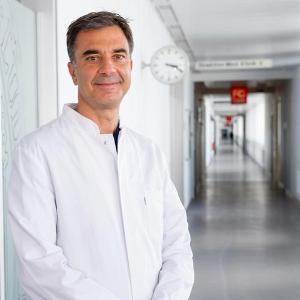Concentrated expertise for medical research transfer
30 Jun 2025
The LMU research center ICON for cardiovascular and metabolic diseases has opened its doors. Steffen Massberg and Eckhard Wolf present the new facility.
30 Jun 2025
The LMU research center ICON for cardiovascular and metabolic diseases has opened its doors. Steffen Massberg and Eckhard Wolf present the new facility.
The newly opened Interfaculty Center for Endocrine and Cardiovascular Disease Network Modelling and Clinical Transfer (ICON) concentrates interdisciplinary research related to diseases of the cardiovascular system in one place. The goal of the research center is to bring innovative therapeutic approaches to clinical application.
Professor Steffen Massberg, Director of the Department of Cardiology at LMU University Hospital, and Eckhard Wolf, Professor of Molecular Animal Breeding and Biotechnology at LMU, discuss the possibilities and goals of ICON.
What makes ICON special?
Massberg: ICON builds a bridge between basic research and clinical application. We have the best possible structural and personnel requirements in place to accomplish this. I know of no other institution anywhere in Europe that is so advanced when it comes to modern approaches to novel cardiac diagnostics and therapies.
Wolf: The unique thing about ICON is that it brings together the various disciplines represented at the Munich campus – human and animal medicine, biology and gene technology, pharmaceutics and chemistry – in one research buidling. The building houses a dynamic assembly of highly specialized research groups spanning diverse disciplines, each possessing exceptional expertise across a wide range of investigative methodologies. We can pool all this expertise and harness it for certain questions related to medical research transfer.
ICON builds a bridge between basic research and clinical application. I know of no other institution anywhere in Europe that is so advanced when it comes to modern approaches to novel cardiac diagnostics and therapies.Steffen Massberg

Prof. Dr. Steffen Massberg | © LMU Klinikum
What does this transfer look like?
Massberg: The participating representatives from the newly founded NUCLEATE Cluster of Excellence, for example, are carrying out research into innovative RNA- and DNA-based forms of therapy, and into targeted ways of delivering certain drugs to the right place in the body, among other things. When an approach like this is relatively far advanced, it will be tested at ICON in a patient-relevant disease model, as the final step before moving on to a technology tested in patients. If the results are promising in the pig model, they will form the basis for the subsequent early clinical studies enrolling patients.
Wolf: Our goal with ICON is to use large animal models to further develop novel therapeutic, diagnostic, and preventative measures until they are ready for use in clinical practice.
Massberg: We’re also seeking closer cooperation with industrial partners. With the start-up campus in Martinsried, we have close geographical connections with young businesses, but we’re also looking for collaborations with larger companies. The closer an application comes to clinical practice, the more important it becomes to get the input of industry.
The focus is on cardiovascular and metabolic diseases, is that right?
Massberg: Yes, because cardiovascular diseases remain the most common cause of death in Germany. In an increasingly older society, the proportion rises of people at risk of and affected by these diseases. Many diseases that affect the heart and the vasculature are metabolic in origin. Strategies aimed at preventing or treating cardiovascular diseases always have to take metabolic causes into consideration.
Our goal with ICON is to use large animal models to further develop novel therapeutic, diagnostic, and preventative measures until they are ready for use in clinical practice.Eckhard Wolf
Wolf: The metabolic part is more in my wheelhouse. For almost 20 years, I’ve been working on the development of pig models for diabetes and other metabolic diseases. Diabetes is an important factor in the development of cardiovascular disorders such as atherosclerosis and cardiac valve diseases. Recently, the research group led by PD Sebastian Clauß demonstrated in one of our pig models that cardiac arrythmias can also be caused by diabetes.

Prof. Dr. Eckhard Wolf | © Jan Greune/Gene Center LMU
Why is it so important to carry out research on pigs?
Wolf: Pigs now play a major role in the approval of drugs. The EU is supporting a project called NHPig to replace safety research for new therapies on non-human primates with testing on pigs. Funded under the Innovative Health Initiative, the collaborative project includes the development of relevant cell culture models and thus makes a substantial contribution to the so-called 3Rs principle.
Pigs are relatively similar to humans physiologically and in their organ structure. The big advantage, however, is that pigs are very suitable for genetic modification. We can reproduce molecular mechanisms from human diseases one to one in pigs. This gives us a much better model than if we study a non-modified pig. Indeed, we can even completely humanize the target structures for certain therapeutics. In such genetically tailored models, we can test the exact substances that are subsequently to be used in humans.
Over the next years, ICON will develop into a nucleus for therapeutic innovations and new imaging possibilities.Steffen Massberg
On our diabetic pigs, for example, we can investigate how diabetes affects cardiovascular diseases. We also have disease models for Duchenne muscular dystrophy, on which gene therapies can be tested that replace the defective gene or correct the reading frame of the gene. To determine with precision how efficient the developed approaches are, we can now exploit the full spectrum of investigation possibilities at ICON.
So what technical facilities does ICON offer?
Massberg: At ICON we have the most state-of-the-art computer tomograph currently at LMU. This so-called photon-counting CT is the next generation of CT imaging and permits extremely high resolution. This is important if you want to image small structures, such as coronary vessels or changes in myocardium. We also have an MRI scanner that permits magnetic resonance tomography on large animals, but also allows us to examine patients who take part in clinical studies. Meanwhile, our PET-CT enables us to establish and test new imaging probes for positron emission tomography, to which end we collaborate closely with our radiopharmacy colleagues here on site.
Furthermore, these imaging techniques allow us to dramatically reduce the number of animals we need, as we can examine one animal on repeated occasions. And so we don’t need to include new animals in an experiment for every round of testing.
At ICON we also have a medically-approved state-of-the-art 3D printer. It allows us to print clinically useful implants such as cardiac valves and vascular prostheses. Our cooperation partners in heart surgery can test these devices for efficiency and safety on large animals and – if successful – advance them to clinical applications.
In genetically tailored models, we can test the exact substances that are subsequently to be used in humans.Eckhard Wolf
There is a surgery area that’s specially optimized for transplants. Researchers are also studying the transplantation of whole organs there. Why is that?
Massberg: Transplants are always associated with damage to the tissue of the transplanted organ. The organ has to be explanted from the donor. After explantation the organ is no longer supplied with blood, which may cause ischemic damage. Because donor organs are scarce, they sometimes have to be transported very long distances to the recipients, which may increase ischemic organ damage. At ICON, we will develop new strategies to minimize the resulting damage and thus improve organ quality during transplantation.
ICON espouses high standards in animal welfare, security, and hygiene. How are the pigs kept at ICON?
Wolf: ICON is not a breeding station; the animals are housed here just for a certain period for research purposes. That being said, we pay great attention to animal welfare. Housing conditions are very flexible and the individual bays can be joined together so that, when capacity allows, the animals are given maximum space to roam around and access to fresh air.
Naturally, our security standards are high. We control exactly who is allowed to enter the facility. And we work only with pigs from strictly controlled breeds where hygiene monitoring is carried out in accordance with the guidelines of the Federation of European Laboratory Animal Science Associations.
What scientific successes do you anticipate in the future?
Massberg: Over the next years, ICON will develop into a nucleus for therapeutic innovations and new imaging possibilities.
Wolf: Our big goal is to validate a treatment strategy for at least one monogenic disease in a large animal model to the point that it can be clinically tested.